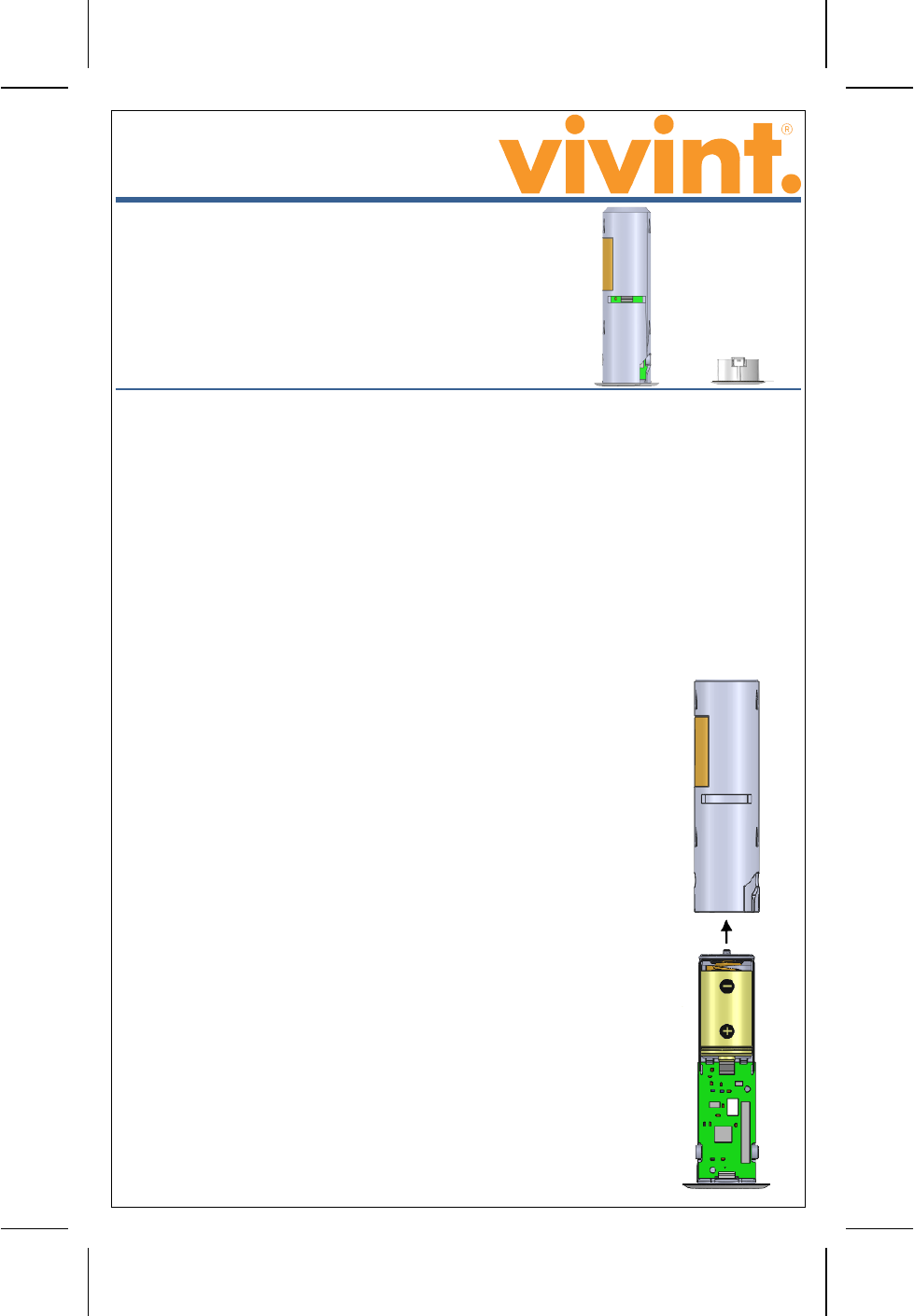Vivint DW01 Security Signaling Equipment User Manual
Vivint. Inc. Security Signaling Equipment Users Manual
Vivint >
Users Manual

Recessed Door Contact
(V-DW21R-345)
Quick Reference
Programming Instructions
(For more details, go to the Support page at: Vivint.com, and the KIM site at: corp.vivint.com/sites/KIM/)
•
Loop 1 (default)
Installer Test
Once installed, open and/or close the door
for which the DW21R is installed so
that
the sensor will transmit to the Vivint Control Panel while the panel is in
installer test mode
.
User Test
Open and/or close
the door for which the DW21R is installed to ensure the sensor is
transmitting correctly to the panel. The panel should recognize the state change of
the door that is being monitored.
PRINT INSTRUCTIONS: REFERENCE SHEET V-DW21R-345 P/N 77-000003-001 REV 1.1 |
INK:
BLACK | MATERIAL: 20 LB MEAD BOND | SIZE: 5.50" X 8.50" SCALE 1:1 |
FOLD
S: TRI-FOLD VERTICAL, TRI-FOLD HORIZONTAL (TO FIT IN BOX)
Installation Instructions
Mounting
tools:
• Power drill
• 3/4" drill bit
NOTE: It is important, to ensure the magnet and sensor line up properly, that the hole for the senor and the
hole for the magnet be directly across from each other.
If the brown caps would look better once installed, remove the white (default) caps and replace them with the
su
pplied brown ones. Insert the battery into the sensor while observing the correct polarity. With the battery
i
nstalled, slide the board and battery into the sensor tube by passing the extended sides through the guide
holes. The tube should twist clockwise, securely into place.
The Vivint Recessed Door Contact (DW21R) is ideal for
inconspicuously monitor
ing the opened and closed state of a door.
The
DW21R sensor includes white and brown plastics to help it
blend in with most doorframes
.
The innovative design allo
ws a user to easily remove the sensor to
change batteries when necessary
.
Installing the sensor:
1. Use a 3/4" drill bit and slowly drill a hole into the door or doorframe for the
sensor. The hole should be approximately 2.75" deep.
2. Insert the sensor so that the lip of the sensor becomes flush against the door
or doorframe.
3. Verify that the sensor is held tightly in place. If it is not, remove the sensor
cap and replace it with one of the included flanged caps and secure it with
the supplied screws.
Installing the magnet:
1. Use a 3/4" drill bit and slowly drill a hole in the door or doorframe directly
opposite of the sensor. The hole should be approximately 1/2" deep.
2. Remove the sticker back from the inside lip of the magnet.
IMPORTANT: Before inserting the magnet into the drilled hole, clean the
excess dust from around the hole to ensure the glue is most effective.
3. Insert the magnet into the drilled hole and hold it firmly in place for a few
seconds to ensure it is securely held in place.

Battery Installation
To replace the battery, twist the sensor counterclockwise while pulling back. The sensor
will then be able to pull directly out
allowing access to the battery. Remove the old battery and insert the
new battery while observing the correct polarity.
FCC and Industry Canada Regulatory Declarations*
CAUTION:
Unauthorized changes or modifications could void the user’s authority to operate the equipment.
This device has been
tested and found to comply with the limits for a Class B digital device, pursuant to Part 15 of FCC Rules and Industry Canada
license
‐exempt RSS standard(s). Operation is subject to the following two conditions: (1) This device may not cause harmful interference, and (2)
This device must accept any interference received, including interference that may cause undesired operation of the device.
These limits are designed to provide reasonable protection against harmful interference in a residential installation.
This equipment generates
, uses, and can radiate radio frequency energy and, if not installed and used in accordance with the instructions, may cause
harmful interference to radio communications. However, there is no guarantee that interference will not occur in a particular
installation. If this
equipment does cause harmful interference to radio or television reception, which can be determ
ined by turning the equipment off and on, the user
is encouraged to try to correct the interference by one or more of the following measures:
• Reorient or relocate the receiving antenna.
• Increase the separation between the equipment and the receiver.
• Connect the equipment into an outlet on a circuit different from that to which the receiver is connected.
• Consult the dealer or an experienced radio/television technician for help.
PRUDENCE!
Changements ou modifications pourraient annuler le droit de l'utilisateur à utiliser l'équipement non autorisées.
Conformément à la réglementation d'Industrie Canada, le présent émetteur radio peut fonctionner avec une antenne d'un type et
d'un gain maximal
(ou inférieur) approuvé pour l'émetteur par Industrie Canada.
Dans le but de réduire les risques de brouillage radioélectrique à l'intention des autres
utilisateurs, il faut choisir le type d'antenne et son gain de sorte que la puissance isotrope rayonnée équivalente (p.i.r.e.
) ne dépasse pas l'intensité
nécessaire à
l'établissement d'une communication satisfaisante.
Le présent appareil est conforme aux CNR d’Industrie Canada applicables aux appareils radio exempts de licence. L’exploitation est autorisée aux deux
conditions suivantes:
(1) l’appareil ne doit pas produire de brouillage, et (2) l’utilisateur de l’appareil doit accepter tout brouillage radioélectrique
subi, même si le brouillage est susceptible d’en compromettre le fonctionnement.
Ces limites sont conçues pour fournir une protection raisonnable contre l
es interférences nuisibles dans une installation résidentielle. Cet équipement
génère, utilise et peut émettre une énergie de radiofréquence et, s'il n'est pas installé et utilisé conformément aux instruc
tions, il peut causer des
interférences nuisibles au
x communications radio. Cependant, il n'existe aucune garantie que des interférences no se produiront pas dans une
installation particulière. Si cet équipement provoque des interférences nuisibles à la réception radio ou télévision, ce qui
peut être déterminé en
mettant l'équipement hors et sous tension, l'utilisateur est encouragé à essayer de corriger l'interférence par une ou plusieurs des mesures suivantes:
• Réorienter ou déplacer l'antenne de réception.
• Augmentez la distance entre l'équipement et le récepteur.
• Connecter l'équipement à une sortie sur un circuit différent de celui sur lequel le récepteur est branché.
• Consulter le revendeur ou un technicien radio / télévision expérimenté pour de l'aide.
FCC ID:
2AAAS‐DW01, IC ID: 10941A‐DW01
*For more compliance and warranty information, visit:
www.vivint.com
WARNING! The polarity of the battery must be observed (as shown in the image). Improper handling of lithium
batteries may result in heat generation, explosion, or fire, which may lead to personal injury. Replace only with
the same or equivalent battery type as recommended by the manufacturer.
AVERTISSEMENT! La polarité de la batterie doit être observée (comme indiqué dans l'image). Une mauvaise
manipulation des piles au lithium peut conduire à la production de chaleur, une explosion ou un incendie, ce qui
peut entraîner des blessures. Remplacez-le par le même type ou équivalent de la batterie tel que recommandé
par le fabricant.
Batteries must not be recharged, disassembled or
disposed of in fire. Disposal of used batteries must be made in accordance
with the waste recovery and recycling regulations in your area.
Keep away from small children. If batteries are swallowed,
promptly see a doctor.
© 2014 Vivint Inc. All Rights Reserved. | www.vivint.com | M/N: DW01 | Doc P/N: 77‐000003‐001 Rev. 1.1
Specifications
Wireless Signal Range
350 feet (106.7 m), open air
Battery
Panasonic CR2 3V
Transmitter Frequency
345 MHz
Code Outputs
Open, Close, Tamper, Low Battery, Loss of Supervision
Supervisory Interval
70 minutes per signal (12 hours for panel to report supervision failure)
Operating Temperature Limits
32° to 120°F (0° to 49°C)
Relative Humidity
5‐95% Non‐Condensing
Wireless Product Notice
Wireless communications hardware provides
reliable communication; however, there are limitations which must be observed.
• The transmitters are required to comply with all applicable wireless rules and regulations. As such, they have limited
transmitter power and limited range.
• Wireless signals may be blocked by radio signals that occur on or near their operating frequencies.